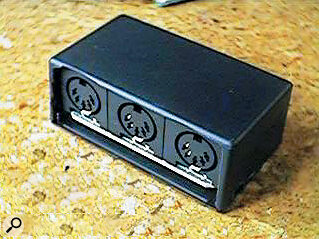 The MIDI 3, from New Zealand Atari hardware developer Mario Becroft, provides cost‑effective MIDI output expansion.
The MIDI 3, from New Zealand Atari hardware developer Mario Becroft, provides cost‑effective MIDI output expansion.
With Hinton Instruments' AudioCalc, your Atari can earn its keep helping out with essential computations in the studio. Derek Johnson finds it all adds up...
Continuing the theme of the last couple of Atari Notes columns, where I looked at previously commercial software which has recently become free to Atari owners, this month I'm looking at a suite that won't help you to make music as such, but may be useful during your musical endeavours. Hinton Instruments' AudioCalc Professional Audio Calculator v1.06 (last mentioned by Martin Russ in SOS Atari Notes December '93) used to retail for around £40. It was a bargain then, for its comprehensive set of music‑ and audio‑specific calculators, and now, if you have a need for its tools, it's an unmissable free download from Hinton's web site (www.hinton.demon.co.uk). If you visit, though, be prepared for a tirade against those Atari users who seem unable to understand the concept of paying for software! The sobering subtext is that it wasn't just a badly managed platform that led to the lack of support for Atari software: piracy took a lot of the profit, and hence motivation, out of the development of new software.
We Can Work It Out
When you download AudioCalc, it will run as a desk accessory on any flavour of Atari ST, TT or Falcon, and will thus be instantly available while you are running your usual music software. It can also be used as a stand‑alone application: simply change its file extension from ACC to PRG, using the Show Info option under the File menu on the Atari desktop.
However you run it, AudioCalc is organised as five spreadsheet‑style calculators, selected from one small main window:
- Sound Calculator: this calculator may seem rather esoteric, but it's pretty comprehensive in live sound terms, and would be worthwhile for anyone concerned with setting up speakers in a large space. For example, when two speaker stacks are some distance apart in a large venue, there is a measurable delay between the sound emitted by one stack in relation to the other and one of this calculator's jobs is to work out what that delay will be. A compensation can then be made by inserting and setting up dedicated delay lines, so that the sound from both stacks reaches the audience at the same time.
- Tape Calculator: though aimed at users of analogue tape, this calculator has applications for samplists and hard disk recordists, since it allows you, for example, to enter a desired pitch change and calculate the varispeed percentage, harmonisation ratio or tempo change (in bpm) needed to produce that pitch change. If you are using tape, the necessary tape speed to realise a given pitch shift or tempo change is also given.
- Music Calculator: the best trick here is the instant calculation, in milliseconds, of the length of various note values at a given tempo — ideal for working out timed delays; the tempo can even be supplied with four decimal‑place accuracy. The other part of this calculator covers SMPTE‑based matters, such as fitting a given length of music into a certain SMPTE time range.
- Analog Calculator: this offers more esoteric calculations, of most use to professional engineers, covering impedance, dB‑to‑RMS calculations and dBu, dBV and dBm conversions. An ideal set of tools for analogue tape‑machine line‑up.
- Digital Calculator: another tool that would benefit samplists and digital recordists, the Digital Calculator lets you work with sample size, bandwidth, format, word length and time. One application of this calculator would be determining whether a sample will fit in a given space.
Smooth Operator
Using the calculators, only one of which can be open at a time, is simple: input the necessary values, press the 'calculate' button, and the software goes to work. The supplied docs are useful, and each calculator has its own 'help' window, which explains briefly and clearly what's going on.
All in all, AudioCalc is a valuable collection of tools. Personally, I'll use the Music calculator most often — timed delays can be tons of fun, but working their values out usually isn't! As with much previously commercial software that is now freely available, AudioCalc comes with no support, but, as the docs say, it doesn't need any!
Kiwi Fruits
Mario Becroft, that intrepid New Zealand‑based designer of Atari add‑ons, has done it again. His new MIDI‑3 is a three‑way MIDI output expander which attaches to the modem port of an Atari ST. When used in conjunction with MIDI sequencing software such as Notator and Cubase, MIDI‑3 provides three extra independently addressable MIDI outputs in addition to the Atari ST's main MIDI Out.
MIDI‑3 is fully compatible with the (discontinued) original C‑Lab Export expander, in that it works with any software that supports Export. The unit requires no extra power or connections, bar plugging into the modem port. It's available in two versions: cased, or uncased for incorporation into recased STs or Falcons. The latter option is marginally cheaper, at NZ$100, as opposed to $110 for the uncased version. UK pricing is currently being negotiated, but is expected to be the right side of £40 for either unit.
Abingdon Synthesis Projects will be handling UK distribution. Contact them for further info at the address below, and watch this column for a proper assessment as soon as I get my hands on a MIDI‑3.
